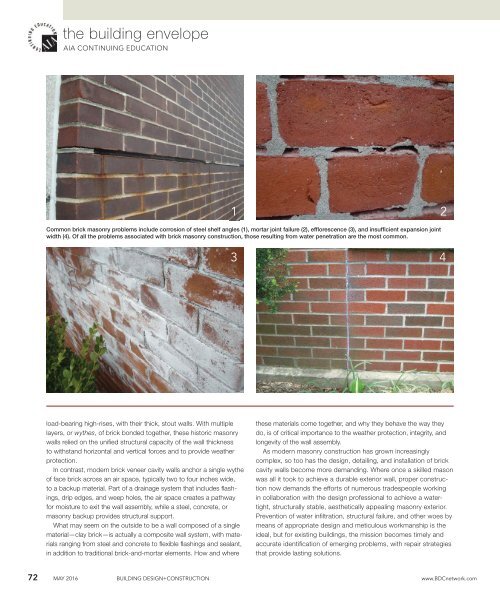Building Design Construction
You also want an ePaper? Increase the reach of your titles
YUMPU automatically turns print PDFs into web optimized ePapers that Google loves.
the building envelope<br />
AIA CONTINUING EDUCATION<br />
1 2<br />
Common brick masonry problems include corrosion of steel shelf angles (1), mortar joint failure (2), efflorescence (3), and insufficient expansion joint<br />
width (4). Of all the problems associated with brick masonry construction, those resulting from water penetration are the most common.<br />
3 4<br />
load-bearing high-rises, with their thick, stout walls. With multiple<br />
layers, or wythes, of brick bonded together, these historic masonry<br />
walls relied on the unifi ed structural capacity of the wall thickness<br />
to withstand horizontal and vertical forces and to provide weather<br />
protection.<br />
In contrast, modern brick veneer cavity walls anchor a single wythe<br />
of face brick across an air space, typically two to four inches wide,<br />
to a backup material. Part of a drainage system that includes fl ashings,<br />
drip edges, and weep holes, the air space creates a pathway<br />
for moisture to exit the wall assembly, while a steel, concrete, or<br />
masonry backup provides structural support.<br />
What may seem on the outside to be a wall composed of a single<br />
material—clay brick—is actually a composite wall system, with materials<br />
ranging from steel and concrete to fl exible fl ashings and sealant,<br />
in addition to traditional brick-and-mortar elements. How and where<br />
these materials come together, and why they behave the way they<br />
do, is of critical importance to the weather protection, integrity, and<br />
longevity of the wall assembly.<br />
As modern masonry construction has grown increasingly<br />
complex, so too has the design, detailing, and installation of brick<br />
cavity walls become more demanding. Where once a skilled mason<br />
was all it took to achieve a durable exterior wall, proper construction<br />
now demands the efforts of numerous tradespeople working<br />
in collaboration with the design professional to achieve a watertight,<br />
structurally stable, aesthetically appealing masonry exterior.<br />
Prevention of water infi ltration, structural failure, and other woes by<br />
means of appropriate design and meticulous workmanship is the<br />
ideal, but for existing buildings, the mission becomes timely and<br />
accurate identifi cation of emerging problems, with repair strategies<br />
that provide lasting solutions.<br />
72 MAY 2016 BUILDING DESIGN+CONSTRUCTION www.BDCnetwork.com






